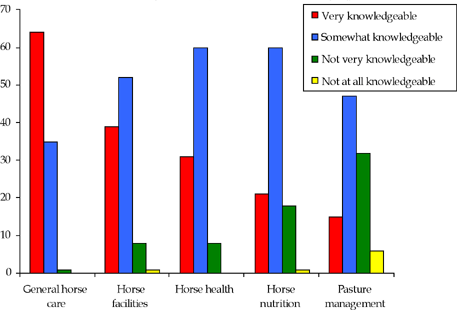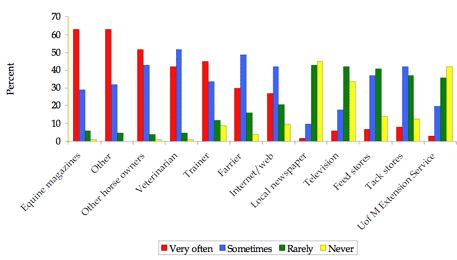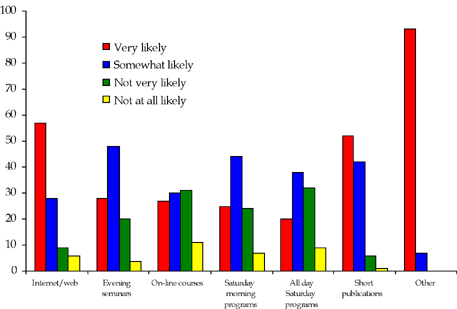December 2006 // Volume 44 // Number 6 // Research in Brief // 6RIB4
University of Minnesota Horse Owner Survey: Building an Equine Extension Program
Abstract
The University of Minnesota conducted a statewide survey of 1,008 Minnesota horse owners to characterize their preferences for education on equine topics. The mail survey engendered an excellent response rate (67%) and clearly identified the need for a statewide horse program in Minnesota. The majority of horse owners currently obtain information from equine magazines, other horse owners, veterinarians, trainers, and farriers. When asked how they would like to obtain horse-related information, horse owners preferred short publications, the Internet, and evening seminars. To the best of our knowledge, this is the first survey conducted to determine the educational needs of horse owners.
Introduction
The Minnesota horse industry has grown rapidly over the last 5 years. In a recent economic assessment, it was estimated that Minnesota's horse industry generates nearly $1 billion in economic activity annually (Burh, 2004). The 2002 USDA Census of Agriculture indicated there were 14,289 horse and pony farms in Minnesota, up 80% from the 1997 census, and 92,770 horses and ponies, up 75% from 1997 (USDA/NASS, 2002).
University of Minnesota Extension Service faculty have been told that Minnesota horse owners would like to have educational programs provided by unbiased and research-based sources. Because little information was available about the specific types of programs desired by horse owners, a survey was needed to document and confirm the need.
The objectives of the survey were to:
Identify topics Minnesota horse owners want to learn about
Identify preferred venues for obtaining new and updated equine information
Determine where horse owners are currently obtaining educational material
Identify the appropriate technical level of equine materials to be developed
Identify possible partners and regional interests for future equine educational programs
Obtain demographic information about horse owners and populations
Evaluate the feasibility and potential success for equine programs that could be offered throughout the state
Methodology
A mail survey of Minnesota horse owners was conducted in the spring of 2004 with assistance from the Minnesota Center for Survey Research (MCSR) and endorsement from the Minnesota Horse Council. The survey was funded by a University of Minnesota Extension Service Agriculture, Food and Environment Capacity Area grant.
A draft questionnaire developed by MCSR was based on questions developed by Extension faculty. The draft instrument was presented to three diverse groups of horse owners. Prior to the start of data collection, changes suggested by these three groups were incorporated into the survey to create the final questionnaire. Questionnaires were then sent to a random sample of 1,008 Minnesota horse owners developed from membership lists solicited from 4H, Pony Club, and various breed and sport organizations that totaled 2,587 names.
The procedures used by MCSR were standard, proven mail survey techniques (Dillman, 2000). Mailing and data collection were conducted from April 2 to May 25, 2004. The first mailing, sent to horse owners on April 2, included the following: 1) a cover letter inviting participation in the survey; 2) the survey instrument; and 3) a self-addressed, stamped return envelope. The second mailing consisted of a reminder postcard, which was sent on April 9 to all horse owners selected to receive the survey. On April 23, a third mailing was sent to all individuals who had not yet returned their survey. This mailing was identical procedurally to the first mailing and included a copy of the questionnaire, a reminder cover letter, and a self-addressed, stamped return envelope.
Response Rate
The survey identified the need for a statewide horse program in Minnesota and gave insight into the topics of interest and how horse owners want to receive horse-related information. The survey had a response rate of 69% (Table 1). Response rates from previous mail surveys have been between 20% (Swinker, Tozer, Shields, & Landis, 2003) and 43% (Downing & Finley, 2005). The higher response rate is indicative of the interest horse owners have in obtaining horse-related information and adds to the reliability of the results.
| Status | Number |
| Surveys Returned | 659 |
| Refusals | 5 |
| Surveys Not Returned | 289 |
| Eliminated Surveys | |
| Duplicate | 3 |
| No Longer a Horse Owner | 19 |
| Non-deliverable Mail | 33 |
| TOTAL SURVEYS MAILED | 1,008 |
| Response Rate = Completed Surveys/ (Total Surveys Mailed – Eliminated Surveys) | |
Demographic Horse Owner Information
Of survey respondents:
The average age was 44 years old, with an average of 14 horses owned on 30 acres.
Less than one child under the age of 18 per household was active in horse related activities.
Approximately 50% of respondents had a 2003 household income (before tax) between $50,000 and $125,000, 25% had income less than $50,000, and 25% had income of more than $125,000.
Forty-nine percent have part of their income generated from horse sales, 46% from breeding fees, 32% from riding lessons and training, 31% from boarding horses, and 16% from hay and straw sales and horse hauling.
Seventy-three percent have owned horses for more than 10 years, and only 5% have owned horses for less than 3 years.
Thirty-nine percent board their horse, while the remaining horse owners keep their horse at their residential property.
Forty-five percent of horse owners who keep their horses on their residential property buy between 81 and 100% of their hay.
Eighty-seven percent of horses are on pasture or grassy turn out during the summer, but only 24% of horses receive their entire nutritional requirement from pasture during the summer months.
Sixty-seven percent indicated that trail riding was the number one activity they participate in with their horse, followed by western pleasure (56%), English (47%), halter (44%), and gaming (27%).
Thirty-five percent are interested in learning more about dressage, followed by driving (32%), reining (30%), cutting (28%), and western pleasure (27%).
Horse owners responding to the survey represented 86 out of 87 Minnesota counties, making this a statewide survey representing both metro and rural horse owner educational needs.
Educational Information Wanted by Horse Owners
The survey indicated horse owners believe they are very knowledgeable on topics relating to general horse care; and somewhat knowledgeable on topics relating to horse facilities, horse health, horse nutrition, and pasture management (Figure 1).
Figure 1.
How Knowledgeable Are You
About the Following Topics?

When asked how important it is that organizations and professionals develop and present educational programs, the respondents ranked veterinarians high (Table 2).
| Rank | Organization/Professionals | Mean Score* |
| 1 | Veterinarians | 3.39 |
| 2 | U of MN College of Veterinary Medicine | 3.35 |
| 3 | U of MN Extension Service | 3.29 |
| 4 | MN Horse Associations | 3.27 |
| 5 | MN Horse Council | 2.18 |
| 6 | Breed Organizations | 3.15 |
| 7 | Local Feed Stores | 2.56 |
| 8 | Tack Stores | 2.46 |
| * 4 = very important, 3 = important, 2 = not very important, 1 = not at all important. n = 659 | ||
When asked what qualities individuals and organizations should possess before they attempt to provide information to horse owners, the number one quality was having quick access to specialists when needed (Table 3). Personally owning their own horse seemed to add credibility to specialists or individuals. It is interesting to note that the respondents rated college/university training in either veterinary medicine or equine management as important. However, being affiliated with a university was not very important, indicating that university employment is not critical but having formal education at the university level is.
| Rank | Characteristic | Mean Score* |
| 1 | Has Quick Access to Specialists When Needed | 3.39 |
| 2 | Has General Knowledge About Many Horse Topics | 3.33 |
| 3 | Provides a Quick Response | 3.23 |
| 4 | Has College Training in Veterinary Medicine | 3.21 |
| 5 | Has Specialized Knowledge About a Few Horse Topics | 3.15 |
| 6 | Personally Owns a Horse | 3.07 |
| 7 | Will Visit Your Farm | 2.86 |
| 8 | Knows Your Farm and Your Horses | 2.85 |
| 9 | Has College Training in Equine Management or Related Discipline | 2.76 |
| 10 | Is Located Close To Your Farm | 2.74 |
| 11 | Is Affiliated With an Equine Business | 2.62 |
| 12 | Is Affiliated With a Horse Organization | 2.57 |
| 13 | Shows/Exhibits Horses | 2.54 |
| 14 | Is Affiliated With a University | 2.34 |
| * 4 = very important, 3 = important, 2 = not very important, 1 = not at all important. n = 659 | ||
Thirty-eight percent of respondents said they had attended one to two horse programs, 15% had attended three to four programs and 10% indicated they had attended five or more programs in the past 12 months. Most respondents who had attended a horse program said they had attended the Minnesota Horse Expo. Forty-eight percent of horse owners who attended programs drove less than 50 miles, 32% drove between 50 and 100 miles and 20% drove more than 100 miles to horse programs. However, 36% of respondents indicated they had not attended a horse program in the last 12 months. The majority of individuals indicated either time constraints, not knowing about the program, or no horse program offered in their area as reasons for not attending.
The majority of respondents currently obtain information from equine magazines, other horse owners, veterinarians, trainers, and farriers (Figure 2). On average, Minnesota horse owners purchase seven magazines, three books, five pamphlets and two videos or DVDs pertaining to horses per year.
Figure 2.
How Often Do You Obtain
Information About Horses from the Following Resources?

When asked where they would most likely obtain horse-related information, horse owners preferred short publications, the Internet, and evening seminars. Saturday morning programs, on-line courses, and all-day Saturday programs were less desirable. The majority of "other" venues listed for obtaining educational material were related to hands-on training sessions by professional trainers (Figure 3).
Figure 3.
How Likely Would You Be to
Obtain Horse-Related Information from the Following Resources?

When asked how likely they would be to attend programs in person in their area, a majority of respondents (90%) were likely to attend programs on horse health, 87% on horse nutrition, 69% on general horse care, 67% on pasture management, and 62% on horse facilities.
The top 10 topics respondents want to learn about were: basic training, vaccinations, hoof care, horse nutrition, colic, equine behavior, proper tack fitting, fly and pest control, when to call a veterinarian, and poisonous plants (Table 4).
| Rank | Topic | Mean Score* |
| 1 | Basic Training | 3.59 |
| 2 | Vaccinations | 3.56 |
| 3 | Hoof Care | 3.49 |
| 4 | Horse Nutrition | 3.48 |
| 5 | Colic | 3.46 |
| 6 | Equine Behavior | 3.39 |
| 7 | Proper Tack Fitting | 3.39 |
| 8 | Fly and Pest Control | 3.32 |
| 9 | When to Call a Veterinarian | 3.29 |
| 10 | Poisonous Plant | 3.24 |
| 11 | Minerals and Vitamins | 3.22 |
| 12 | Liabilities for Horse Owners | 3.19 |
| 13 | Buying Horse Hay | 3.17 |
| 14 | Equine Dentistry | 3.14 |
| 15 | Supplements | 3.11 |
| 16 | Pasture Management | 2.88 |
| 17 | Weed Control | 2.86 |
| 18 | Storing Hay and Grain | 2.83 |
| 19 | Grazing Habits | 2.82 |
| 20 | Breeding and Foaling | 2.81 |
| 21 | Pasture Establishment | 2.76 |
| 22 | Environmental Impacts of Horses | 2.74 |
| 23 | Fencing Options | 2.69 |
| 24 | Horse Facility and Design | 2.69 |
| 25 | Manure Management | 2.67 |
| * 4 = very important, 3 = important, 2 = not very important, 1 = not at all important. n = 659 | ||
Applying Survey Information to Develop Extension Programs
The survey data suggest that Minnesota horse owners are interested in becoming more knowledgeable in various areas of equine management. University faculty may need to combine less desirable topics (e.g., manure management) with more desirable topics (e.g., vaccinations) to ensure that horse owners get all of the information they need.
One key piece of information provided by the survey was that Minnesota horse owners want veterinarians and local businesses included in Extension programs. As a result, five programs for horse owners were held across the state in February and March of 2006. These programs included local equine industry personnel as well as university faculty. These programs were very successful as indicated by high attendance (676 total participants) and positive evaluation ratings. The results of these meetings confirmed that programs involving local equine businesses can be successful, most likely because horse owners have a level of trust for local businesses. The positive response to programs with industry involvement supports the validity of the survey data, which indicated horse owners wanted industry involvement.
The Minnesota horse owner has different educational interests and needs compared to other clients that the agriculture division of the Extension Service is familiar with serving. Evaluations from the 2006 programs indicated that approximately 80% of participants were unfamiliar with the Extension Service and/or University of Minnesota horse programming. Eighty-four percent of the attendees were female between the ages of 30 to 50 years old, revealing the need for and importance of providing equine education to adults. Program evaluations will continue to provide constant feedback and needs assessments for adult equine educational programs. There were numerous similarities between program evaluations and survey data, primarily in participant demographics and topics participants want to learn about. These similarities further reflect the validity of the survey results.
Results of the survey were also used to develop the University of Minnesota Horse Team. This was a challenging task because there are no University of Minnesota faculty members with a significant Extension appointment in the area of equine science. However, the survey helped convince departments and colleges within the university of the need for equine Extension programming. The University of Minnesota Horse Program Team now consists of 15 faculty members from nine departments or colleges.
The majority of strategic planning, vision and leadership responsibility for the program comes from team members in the Extension Service, the Department of Animal Sciences, Department of Agronomy and Plant Genetics, University of Minnesota Equine Center, College of Veterinary Medicine, and the University of Minnesota at Crookston. The Horse Team also involves equine industry through input from the Equine Advisory Committee. This committee meets with the Horse Team and consists of local veterinarians, feed salespeople and nutritionists, hay producers, farriers, and Minnesota Horse Council Members.
Conclusions
To the best of our knowledge this is the first survey conducted to determine the educational needs of horse owners. Using surveys to identify educational needs in Extension is not new (Downing & Finley, 2005; Lichtkippler, 1986), but educational needs of horse owners have not been previously reported. Other surveys have focused on equine breed numbers, economics, demographics (Swinker, Tozer, Shields, & Landis, 2003; Geene, 2002) and characteristics of 4-H equine volunteers and leaders (Rusk, Kerr, Talbert, & Russell, 2001). Perhaps this is because horses and horse owners have been considered "alternative" agriculture or "hobby" farmers. However, this is no longer the case as the horse industry has grown quickly and has become a major part of several states' economies (USDA/NASS, 2002).
The excellent response rate to this survey is indicative of the eagerness of horse owners to improve their knowledge regarding equine topics. From our experience, obtaining high response rates is a combination of pre-survey focus groups, endorsement by local organizations, assistance from a professional survey center, and multiple mailings.
Because of the information learned through the horse owner survey, the Horse Team has reached a new audience, determined how that audience wants to obtain information, and has forged partnerships with private industry. The survey has helped the Extension Service lay the groundwork for a solid, long-term relationship with horse owners and equine industry in Minnesota. The methods and applications of this survey may be extrapolated and used by other states with underserved horse owner populations or in other areas of Extension.
References
Buhr, B. (2004). Economic value of horses in Minnesota. [On-line]. Available at: http://www.extension.umn.edu/horse/components/pdfs/EconomicValueHorsesMN.pdf
Dillman, D. A. (2000). Mail and Internet surveys: The tailored design method. (2nd Edition) New York, NY: John Wiley & Sons, Inc.
Downing, A .K, & Finley, J. C. (2005). Private forest landowners: What they want in an educational program. Journal of Extension, [On-line], 43(1) Article 1RIB4. Available at: http://www.joe.org/joe/2005february/rb4.shtml
Greene, B. (2002). Vermont equine survey. [On-line]. Available at: http://www.vermonthorse.com/vhc02/equinesurvey.html
Lichtkoppler, F. R. (1986). Surveys help program development. Journal of Extension, [On-line], 24(4). Available at: http://www.joe.org/joe/1986winter/iw2.html
Rusk, C. P., Kerr, C. A., Talbert, B. A., & Russell, M. A. (2001). Profiling Indiana's 4-H horse and pony leaders. Journal of Extension, [On-line], 39 (4). Available at: http://joe.org/joe/2001august/rb3.html
Swinker, A.M., Tozer, P.R., Shields, M.L., & Landis, E.R. (2003). Pennsylvania's equine industry inventory, basic economic and demographic characteristics. [On-line]. Available at: http://www.das.psu.edu/user/equine/pdf/EquineSurveyResults-Academic.pdf
United States Department of Agriculture/National Agricultural Statistic Service. (2002). [On-line]. Available at: http://www.nass.usda.gov/census/
